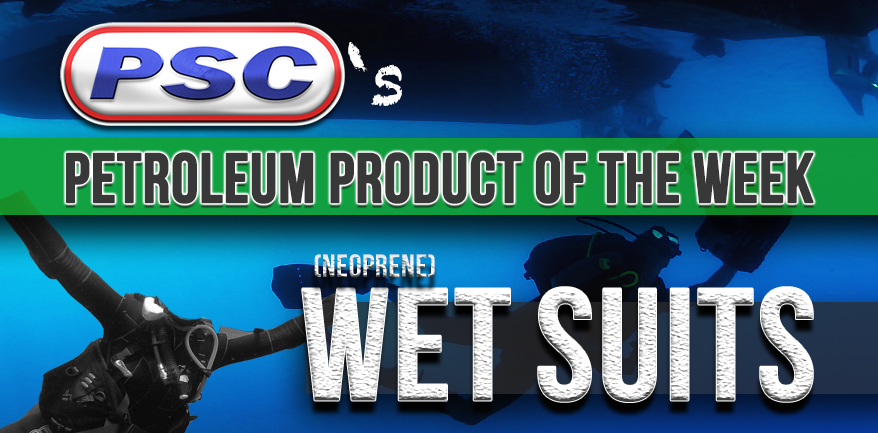Petroleum Product of the Week: Wet Suits
By on Jun 24 2016

Wet is uncomfortable.
Until 1952, nobody had a working solution to wetness. From the beginning of time through the year 1951 AD, swimmers, surfers, and unfortunate lummoxes dove, plunged, and accidentally toppled overboard into 45 F ocean-water and surely enough, it felt exactly how you'd expect.
With the advent of polymerization, new, never-before-seen materials were capable of being produced for a variety of purposes. Put simply, polymerization is a process in which molecules are chemically joined to form long, networked chains of monomers that are referred to as polymers.
There's many different types of plastics, but most are derived from petroleum distillates.
Polymers are mainly used in the production of plastics but have a dynamic range of uses.
Many of these polymers are derived from petroleum processing wherein crude oil is refined and eventually cracked to output petrochemicals, or petroleum distillates. Petrochemicals (ethylene, propylene, benzene, butadiene, etc.) are used widely in the manufacturing of many common household products.
One of these petrochemicals, butadiene, is used in the production of polychloroprene: more commonly known as NEOPRENE! (Phew for a second I thought I'd lost you).

Neoprene is used to make a variety of products that are resistant to water, oil, cold, heat, you-name-it. Perfect for wet suits.
Some of the more common products include winter gloves, fishing waders, joint braces, lunch bags, bathing suits, sports gear, oven mitts, beer coasters, and finally, WET SUITS. While some modern wetsuits are made from limestone (hint: they're not green either), the large majority are made with petroleum distillates.
Neoprene was invented by a group of scientists at DuPont, the 200-year-old, world famous chemical company (that originally began as a gunpowder mill) in 1930. Initially dubbed DuPrene, " the makers of the resilient material decided to drop the patent and name it neoprene, marketing it as ...an ingredient, not a finished consumer product. " The marketing scheme worked, and neoprene brought along huge profits for the DuPont Company.
The modern wetsuit is assembled piece by piece with a special glue.
Almost 20 years later following the production of countless consumer products made from neoprene a totally rad physicist from University of California, Berkeley invented the modern wetsuit. Well, almost modern; Hugh Bradner came up with the idea using a thin layer of fabric to act as thermal insulation in the presence of water the idea of the wet suit was born, but the usage of neoprene was later suggested by a friend and engineer, Willard Bascom. These initial wetsuits struggled to make much of an impact; while Bradner wasn't awarded a patent for his design (it was deemed too similar to a flight suit), he did however receive this sweet little moniker as payment: the father of the modern wetsuit. "
Water-proofing the inside seams.
In 1952, a bodysurfer named Jack O'Neill shortly thereafter took up the idea and ran with it; his brand O'Neill, is one of the longest standing and most successful private surfboard and surfwear companies in the world. (Bradner didn't let it phase him, though he succeeded in doing some pretty amazing things in the name of physics, oceanographic research, and astronomy.)
So, next time no matter if you're on the beaches of sunny California, Hawaii, Vancouver Island, or Alaska send your thanks heavenward to Mr. Hugh Bradner and whomever else you may wish to thank.






